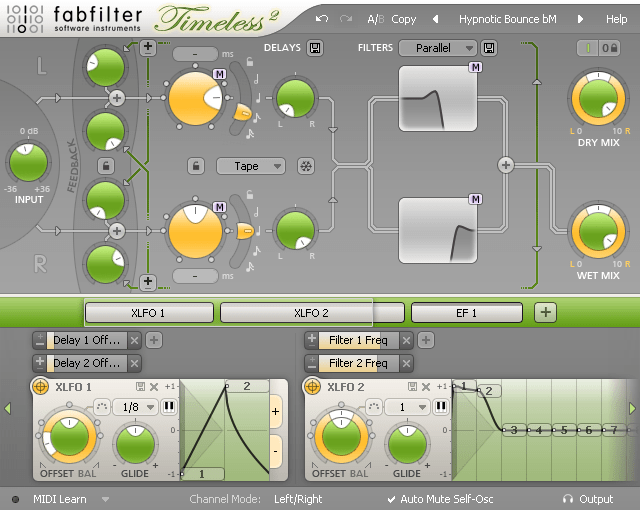
The delay lines have all the features you’d expect. The delay section is based on two delay lines, one for each side of a stereo track.

But as you read further, you’ll see that these aren’t your ordinary delay lines, they’re not your ordinary filters, and this is not even close to your ordinary routing and modulation. At it’s core, Timeless is based on two delay lines being fed into two filters. This is a delay designer, and it can do things you’d never expect from a delay plugin (and some things you’d never expect from any regular plugin). This is not your average delay with only a handful of different sounds. If it wasn’t already obvious, Timeless is a deep plugin. What do all these controls do? Does a delay really need 32 knobs? And can it still do simple echo? Read on… Four feedback knobs (that’s a LOT of feedback!), that tape/stretch switch (do we get to stretch the tape?), yellow rings around some of the larger knobs, and what looks like a synth envelope tucked in the bottom right (with separate knobs for attack, decay, sustain and release). But some strange controls might not be immediately obvious. After poking around a bit you might start to recognize some familiar controls such as delay time, wet/dry levels, filter frequencies, etc.

Timeless has 32 knobs (plus assorted other controls) tightly packed into the plugin window.

Or are you the kind of person who wants to use your delay plugin to make noises that no delay plugin ever should? How much control over a delay plugin do you need? Delay time, feedback, mix level? Maybe a couple more knobs for tone? Or maybe you’re the kind of person who wants a bit more control – perhaps you want to do ping pong delays or even a bit of modulation? It can be a bit of a fiddle to set up, but it rewards those who delve deep. Timeless is a great all-rounder that can also make some extremely strange sounds when you want it to. Tricky overdrive and feedback behaviour, easy to get carried away Great sound, tons of flexibility, inspiring presets


 0 kommentar(er)
0 kommentar(er)
